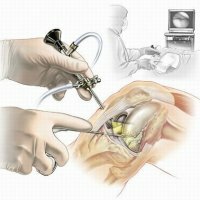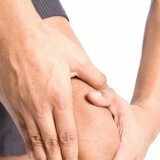Hygroma
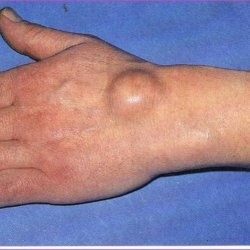 Hygroma is a benign cystic tumor of the synovial joint of the joint connected to the joint. Hygroma - the formation of a rounded shape, covered with normal skin, a dense consistency, up to 3 centimeters in diameter, is inactive, because it is fixed at the base. Often the most effective method of treating this disease is surgical intervention, however, and treatment of hygroma with folk remedies can give its result.
Hygroma is a benign cystic tumor of the synovial joint of the joint connected to the joint. Hygroma - the formation of a rounded shape, covered with normal skin, a dense consistency, up to 3 centimeters in diameter, is inactive, because it is fixed at the base. Often the most effective method of treating this disease is surgical intervention, however, and treatment of hygroma with folk remedies can give its result.
Causes and symptoms of hygroma
There is no clear cause of hygroma development. There is a connection with immense physical loads, traumas, but in some cases the tumor is formed for no apparent reason.
A small bulging is formed on the skin, inside of which there is a cherry or pea.
The hygroma "loves" to localize in the area of the wrist joint( lipoma of the hand), which causes considerable inconvenience. Sometimes education is localized in footsteps and elsewhere. Since the hygroma is cohesive with the joint, it can happen that the fluid will flow into the joint cavity. In this case, it seems that the tumor has disappeared, which eventually reappears.
 Hygroma has the ability to exist for a long enough time and without causing annoying sensations. Some people with this tumor live their whole lives without paying any attention to it.
Hygroma has the ability to exist for a long enough time and without causing annoying sensations. Some people with this tumor live their whole lives without paying any attention to it.
If the hygroma has a non-aesthetic appearance, it causes pain during movement, causes inconvenience, actively increases, then you should think about the operation.
Traditional treatment of hygroma
Over a period of time, gingival treatment trials have shown that conservative methods of treatment are ineffective, and in most cases relapses often occur.
Squashing the hygroma is a painful and incorrect method in which fluid enters the joint cavity, or the tumor envelope bursts and its contents "poured" into the tissue. After a while, everything returns, as they say. Often, the site of the injured hygroma develops an inflammatory process up to suppuration. Thus, after this method the membrane heals, its tightness is restored, but the hygroma develops again.
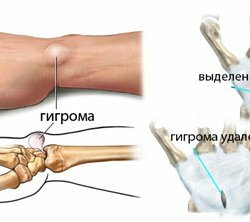 Hygromus was tried to puncture, that is, using a syringe to suck the contents, and inject different substances. The cavity decreases for a while, but the shell remains in place, and sooner or later the fluid accumulates again in this shell.
Hygromus was tried to puncture, that is, using a syringe to suck the contents, and inject different substances. The cavity decreases for a while, but the shell remains in place, and sooner or later the fluid accumulates again in this shell.
The most effective method of treating hygroma is now the surgical intervention with complete excision. Therefore, the main guarantee of no relapse is a radical operation.
The operation lasts about half an hour, is performed under local anesthesia, the sutures are removed on the seventh-tenth day after the operation. Operation under general anesthesia is carried out if the hygroma is large and complex localization.
Treatment with folk remedies
For the treatment of hygroma folk medicine, you can use the following recipes:
- We rip the fresh bitter wormwood, and crush it until the juice forms. The juice extracted in this way is applied to the diseased area and left for the night.
- We use 70% alcohol in the form of lotions, on top of which you should put a cellophane and a warm scarf.
- We pass through the meat grinder the leaves of cabbage, squeeze the juice through the cheesecloth and drink it twice a day half a cup before meals. We drink for one month. At the same time we apply a cabbage leaf, smeared with honey, on top of which a warm handkerchief should be placed over the diseased area.
- Make compresses with pieces of the body of a jellyfish or a tea mushroom.
- Wet a cloth napkin( tissue should be natural) in urine, apply to a sore spot, cover with cellophane and wrap it with a warm scarf.
- We take haystrap, pour boiling water and in this infusion we soar a sore spot, then we rub this place with petroleum jelly.
- Steam for half an hour in hot water, pouring hot water from time to time, then grease the steamed hand with honey, we put parchment paper on top and wrap our hand. The procedure is repeated every day.
- Grind 6 leaves of ficus, fill 500ml of purified kerosene, insist in a dark place for 10 days, filter. We moisten the gauze bandage in sunflower oil and apply it to a painful place, we put a linen napkin moistened in a tincture of ficus on top, cover everything with cellophane and bandage it. Compress hold for 15-30 minutes, while monitoring the sensations so as not to cause a burn. The procedure is advised to do three or four times a day.
- We take in equal doses honey, Cahors, aloe( aloe must not be less than 3 years and it should not be watered for a week).Everything is mixed, in the evening we put it to the sore spot, we cover it with cellophane and heat it up.
- In equal proportions we take the pulp of aloe and honey, add rye flour until a soft cake is put on the sore spot for the night, a cellophane and a warm kerchief are placed on top. Each time, a new cake should be applied.
-
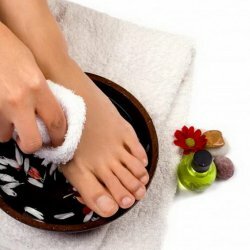 Take wet blue clay and make compresses from it, hold it until it dries( no more than two hours).Re-clay should not be used, it is better to make a fresh compress.
Take wet blue clay and make compresses from it, hold it until it dries( no more than two hours).Re-clay should not be used, it is better to make a fresh compress. - Half a bucket of young pine sprigs is poured over with water, boiled for 20 minutes, we insist 5 to 10 hours, filter. We warm the infusion to a tolerable temperature, and we water the wounded hygromous, use all the infusion obtained.
At the same time from rye flour, a small amount of yeast and soda we knead bread, bake bread, without waiting for the dough to come up. Finished bread cut across into two equal tortillas, put half a loaf of one tablespoon of any salt, and put flat cakes on the diseased area on both sides, we put cellophane and warm handkerchief on top. The procedure is best done at night.
Bread should be baked every time a new one, and the solution can be used up to 5 times. The solution must be hot. Procedures are done every day for one month.

